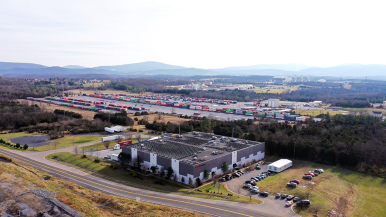Westward ho!
SWVA inland port plan gains momentum
Beth JoJack //April 27, 2023//
Southwest Virginia’s leaders feel confident their region will be home to the state’s next inland port.
“The planets are aligning for us right now,” says state Sen. Todd Pillion, R-Washington County. “Our localities are excited about it. The state seems to be excited about it.”
During the Virginia General Assembly’s regular session, Pillion and two Southwest delegates requested a total of $65 million in state funding to acquire land and build an inland port in the Mount Rogers Planning District, which ranges from Bristol, Virginia, to Wytheville. If built, it would be the state’s second inland port, joining the Port of Virginia‘s Virginia Inland Port in Warren County.
The General Assembly adjourned in February without amending the state’s biennial budget, and it was unclear whether legislators would come to an agreement on the budget before reconvening in April. Nonetheless, lawmakers from Southwest Virginia feel confident the final budget will include funds for establishing an inland port, an intermodal terminal where sea cargo moves by road or rail to inland destinations.
As of February, the state Senate’s proposed budget included $10 million for the Southwest inland port, while the House of Delegates’ budget added $55 million to cover preliminary engineering and design for the inland port, as well as property acquisition and construction and equipment costs.
“I think everyone is committed to putting enough money into it so that we can get as far as we can get before the end of the biennium,” and then allocate enough money to finish the project in the 2024-25 budget, says Del. Israel O’Quinn, R-Washington County.
The only question now, according to O’Quinn, will be whether the state’s budget conferees pick a number closer to $10 million or $55 million in the amended budget presented to the full General Assembly. Gov. Glenn Youngkin spoke positively about the idea of a second inland port last fall.
First in nation

Virginia was the first U.S. state to build an inland port, when it opened the Virginia Inland Port on 161 acres near Front Royal in 1989. Sitting next to Norfolk Southern Corp.’s Crescent Corridor railway and near the intersection of interstates 66 and 81, VIP is owned by the Virginia Port Authority and connects to the Port of Virginia’s marine terminals in Hampton Roads by 220 miles of rail.
The VIP handled 31,282 containers in fiscal year 2021, and its total economic impact that year was $1.3 billion, with over $360 million in labor income from almost 6,000 indirect workers, according to a report released by William & Mary’s Raymond A. Mason School of Business in 2022. These are small numbers next to the Port of Virginia’s total economic impact of $100.1 billion in 2021, but the inland port is nonetheless an economic driver in the Shenandoah Valley, and a similar facility in Southwest would be, too, proponents hope.
In Front Royal, numerous distribution centers for companies like Home Depot Inc.,
Family Dollar Stores Inc. and Red Bull have opened near the inland port, and Harrisonburg-based InterChange Group Inc. has built a healthy business providing warehouses to national corporations.
Supporters of inland ports tout how the facilities alleviate highway traffic and increase capacity at busy coastal ports.
By enabling freight to travel further by train instead of trucks, “the emissions will be less and you will also reduce congestion on the roads,” points out Ricardo Ungo, director of Old Dominion University’s International Maritime, Ports & Logistics Institute.
Since 1989, numerous other U.S. cities, from Dillon, South Carolina, to Dallas, have followed Virginia’s lead in establishing their own inland ports in hopes of spurring economic development, but not every U.S. inland port has been a success story. The elephant in the room is the $32 million Heartland Intermodal Gateway in Prichard, West Virginia, which opened in 2015. One study promised the port would create between 700 and 1,000 jobs. Instead, the facility shut down in 2019 due to lack of demand.
Moving freight

Local officials haven’t always embraced the logistics industry in Virginia. In 2008, Montgomery County sued to stop Norfolk Southern from building an intermodal freight terminal in Elliston, arguing that the facility didn’t fit with its long-term goals for smart growth and high-tech jobs. The state had agreed to pay 70% of the $35.5 million price tag.
The Virginia Supreme Court ultimately ruled against the county, but by then market conditions had changed, and Norfolk Southern hasn’t moved forward.
In recent years, state lawmakers asked for funding to study whether an area on U.S. Route 58 near Danville or somewhere in the Roanoke and New River valleys could work as sites for inland ports, but those bills failed to make it out of the General Assembly.
In 2022, though, legislators approved funding for a state study to determine feasibility of a new inland port in Southwest Virginia or the Lynchburg region.
Robert Martinez, vice president for freight and economic development at global advisory firm Moffatt & Nichol, found while conducting the study that the idea of establishing a port in the Mount Rogers Planning Region had statewide support.
“There does seem to be quite a good echo in the General Assembly, including from folks who are not in Southwest Virginia, who say, ‘That’s kind of a good idea for Virginia,’” Martinez says.
Moffatt & Nichol’s data, used by the port authority and the Virginia Economic Development Partnership to complete the report, showed that the Lynchburg area didn’t “currently have the demand to justify the development of an inland port,” but Southwest Virginia meets “enough market-driven and physical conditions to warrant additional assessment.”
A new inland port could help entice businesses that have previously bypassed Virginia for ports further south, points out Will Payne, managing partner of consulting firm Coalfield Strategies LLC and head of business development for InvestSWVA, a business-attraction campaign for the region.
“The real coup would be grabbing freight business from northeast Tennessee that currently heads to Charleston,” he says. “Virginia’s port simply offers a better business proposition. We just need to convince [company executives] of that.”
The study confirmed what O’Quinn already understood.
“We’ve known all along that we are in a really good location for transportation and logistics,” the delegate says. “We’re a day’s drive from 60% of the United States. We’re less than two hours from five different interstates. We’re in a pretty sweet spot here.” continued on page 6
Thoughtful planning
Moffatt & Nichol selected two locations where an inland port would work in Southwest Virginia but did not identify the sites in the study. According to Pillion, one of the sites is Washington County’s Oak Park Center for Business and Industry, a 338-acre property along U.S. 11. He declined to name the second location, other than to say it’s in Wythe County.

In January, Washington County’s Industrial Development Authority voted to “donate all acreage necessary” in Oak Park for the new inland port. Later in the month, Washington County supervisors passed a resolution in support of establishing an inland port in the county.
It may be too soon to plan a groundbreaking ceremony, though. Devon Anders, president of Mount Crawford-based InterChange Group Inc. and a board member for the Virginia Maritime Association, cautions that careful planning will be key to building a successful inland port in Southwest Virginia.
“It’s worthwhile to continue to pursue [it],” he says, but “I would not just go there and put one in just because it looks like it’s a good location on Interstate 81.”
Will Fediw, vice president of industry and government affairs for the Virginia Maritime Association, agrees with Anders’ assessment. “The VEDP and the port authority will now basically have to figure out the best way to thoughtfully move forward with some sort of study in partnership with some of their stakeholders — like the railroad [and] their customers who are moving cargo — to figure out exactly what’s the right design,” he says. “When is the right time for this type of potential inland port?”
The feasibility study noted that an inland port would need to make at least 20,000 freight transfers per year for the port to succeed. In the Mount Rogers area plus the broader geographic market of Giles and Pulaski counties and northeastern Tennessee, the study’s authors say, an inland port in Southwest Virginia could generate that volume.
Spokespersons from both the Port of Virginia and VEDP declined to comment for this story.
O’Quinn says VEDP and the port authority are currently identifying companies that would use a Southwest port, as well as whether they’d provide enough business to make the port cost-effective. As for Pillion and himself, O’Quinn says it’s time for action on a state level.
“We actually just said flat-out to some people, ‘I’ll tell you one thing we’re not going to do and that is study this again, because here it is. The information is fresh. It’s going to work.’”
t
















